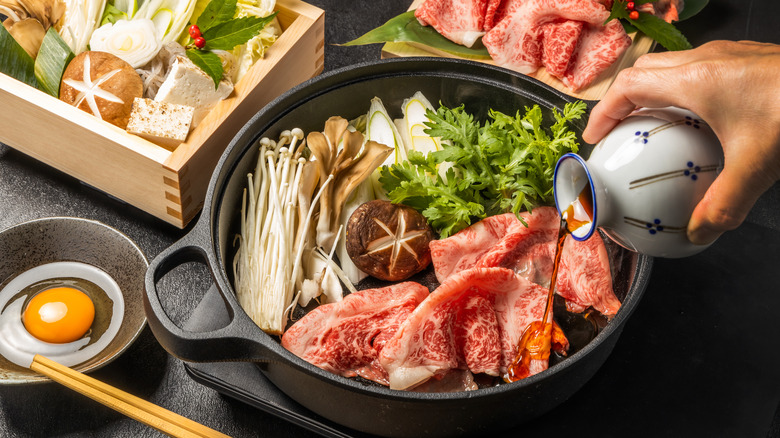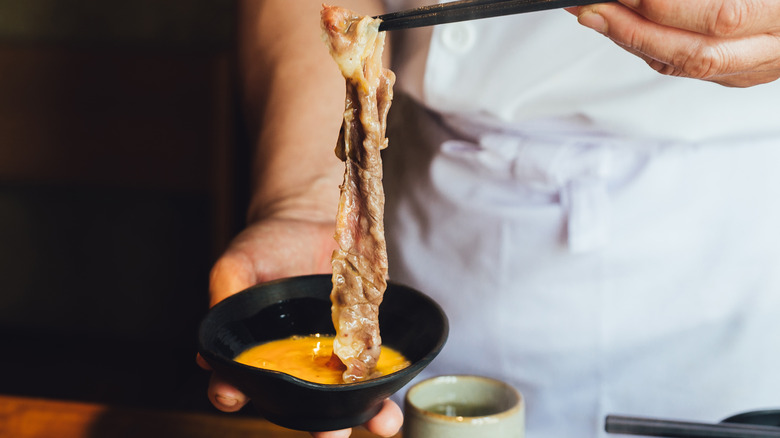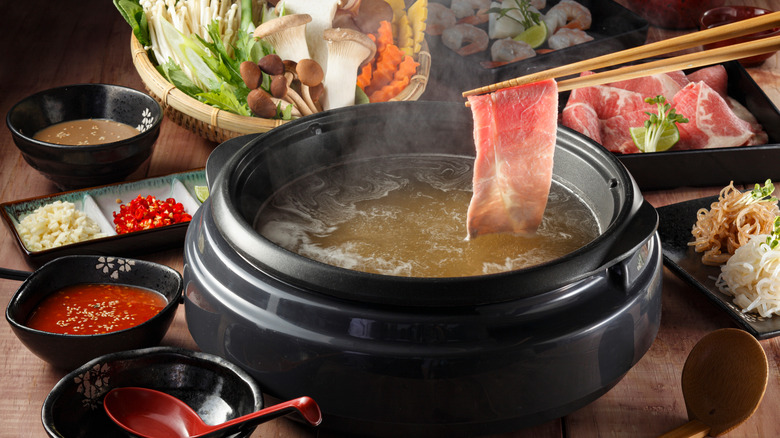The Difference Between Sukiyaki And Shabu-Shabu Hot Pots
Nestled in a quaint Japanese restaurant, among soft whispers and the rhythmic clinking of dishes, you find yourself in a delightful culinary conundrum. The menu, a treasure trove of comforting hot pot dishes, beckons you to decide between two inviting offerings. Which will you order tonight — the sukiyaki or shabu-shabu?
These two popular dishes, known for their communal nature, stand as quintessential examples of Japanese comfort food, bringing conviviality and intimate experiences to diners across the globe. Both center around a simmering pot of broth and an assembly of high-quality ingredients like wagyu and Kobe beef.
Despite their shared roots in the broader hot pot family, sukiyaki and shabu-shabu are distinct culinary experiences. Yet these dishes are often mistaken as interchangeable, a confusion arising from their shared background, hot pots, and broth use. However, each sings a unique symphony of flavors, varying cooking methods, and differences in how to use the sauce.
Sukiyaki broth is sweet and savory and a raw egg often serves as a dipping sauce
The harmonious blend of sweet and savory sets a typical sukiyaki broth apart. A sweet sauce, warishita, made with sugar, mirin, sake, and soy sauce, is added to the dashi base. You can say that most sukiyaki broths have a similar taste, thanks to warishita.
Well-marbled slices of beef, like wagyu, are often par-cooked in a grill or frying pan then added to the flavorful broth. Accompanying the beef is an assortment of vegetables (like cabbage and carrots), soft tofu, and mushrooms (enoki and shiitake), each contributing a unique texture and depth to the dish. Sukiyaki arrives at the dining table, pre-cooked and ready to eat while kept hot in the boiling hot pot broth.
A raw, beaten egg in a bowl is usually served alongside the sukiyaki hot pot, intended as a sauce for the diner to dip cooked ingredients into. The room-temperature egg cools down the beef and adds a velvety, creamy texture and a mellowing egginess that tempers the sweet-savory flavors of the broth.
Note that with sukiyaki, there are two main styles, Kanto and Kansai, and the style we described is akin to a mix of the two. In different regions, other ingredients may be used, like pork instead of beef. Also, historically in Japan, sukiyaki is often reserved and cherished during special occasions, from family gatherings and celebrations of milestones to year-end parties.
Shabu-shabu broths are more subtle and food is swished into the hot pot at the table
Unlike sukiyaki, partaking in shabu-shabu is a more casual experience and doesn't have to be reserved for special occasions or celebrations. And while sukiyaki is believed to have been invented in the 1800s during the Edo period, shabu-shabu, in relation, is a more modern addition to Japanese cuisine, making its first appearance in the mid-20th century in a restaurant in Osaka.
With shabu-shabu, the broths can vary and are often lighter than sukiyaki broth, like a simple vegetable or chicken-based broth or kombu dashi. The broth comes boiling in a hot pot, and all the ingredients, like raw beef, vegetables, tofu, noodles (like udon), and mushrooms, are set around it, and you do most of the cooking at the dining table. The meat and other components are momentarily swish-swished ("shabu-shabu") in the hot broth until just cooked. And instead of a raw egg, dipping sauces like ponzu and soy sauce are served on the side.


